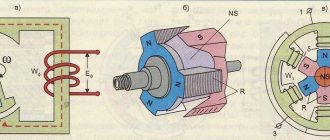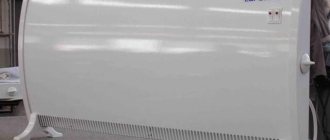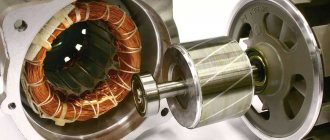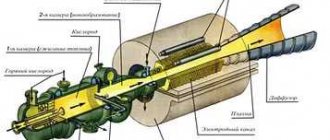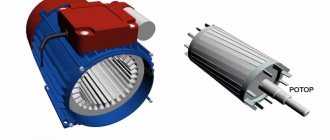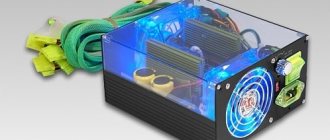The first contribution was made by Michael Faraday, who in 1831 created a prototype electric generator in which an electromotive force was induced in a rotating conductor under the influence of a magnetic field. The second inventor was Rudolf Diesel, who in 1892 received a patent for an internal combustion engine with increased efficiency. Let us note that the design of a diesel generator in a familiar modern design was developed 100 years later, and the mass production of diesel power plants was organized by Perkins and Caterpillar.
Typical design of diesel fuel installations
Structurally, all diesel generators belong to the category of multi-purpose devices with internal combustion engines. The stations are produced in two types, providing for fixed and mobile use, depending on operating conditions.
Almost all diesel power plants are a fairly complex mechanism assembled from various parts and components.
The main components of the DES are:
- Four-stroke diesel engine. The number of cylinders ranges from 1 to 8 and corresponds to the declared performance of the unit.
- Fuel system and air injection equipment. The mixture components enter the engine separately. Diesel fuel is sprayed into the cylinder through nozzles by a fuel pump, and air is pumped by a turbocharger. Under the influence of pressure, the air is strongly heated, igniting the atomized fuel.
- A cooling system that removes excess heat from heated parts and maintains the required temperature level. The coolant is water or antifreeze. Its movement inside the water jacket occurs through special channels, under pressure created by the water pump. At the end of the complete cycle, the coolant returns to the radiator tank and reduces the temperature under the action of the fan blades.
- Generator set. Produces electric current and, depending on the modification, can be single-phase (220 V) or 3-phase (380 V and above) type.
- Automatic control system. Better known as the automatic reserve entry system. This equipment automatically turns on the generator without operator intervention.
- Fuel tank. A fairly spacious tank with a volume of 200-300 liters.
- Frame. Metal frame on which all components and parts are placed. Damper pads are installed at the fastening points to provide protection against vibration vibrations.
- Container capacity, also known as casing. Installed on top of the entire structure, it protects the station from external negative influences. Reduces the noise level produced during operation.
What is a diesel generator
Diesel generators are a liquid fuel source of electricity. They are stationary or mobile power plants that convert mechanical (kinetic) rotational energy into electrical current. Thus, diesel generators provide autonomous power supply to any facility.
Principle of operation
The operating principle of a power plant is based on the interaction of all parts and components included in its design. It is included in the rules for the technical operation of diesel power plants. All such products are manufactured in a stationary or mobile design, and are used as autonomous, emergency or backup power sources.
The basis of any power plant is a diesel generator, which contains an engine and a generator set. Both components are connected to each other through a special coupling, which allows the torque to be converted into electrical energy.
The operation of diesel electrical installations occurs in a certain algorithm:
- Air mass is injected into each cylinder under high pressure. In a confined space, it is compressed and heated to a high temperature. After a certain period of time, fuel sprayed in the injectors is supplied to the cylinders. Under the influence of heated compressed air, diesel fuel vapors ignite, expand and create high pressure in the internal space of the cylinder.
- The hot gas mixture pushes the piston, causing the crankshaft to rotate. The motor starts up and transmits its torque to the generator rotor through a clutch.
- As a result of transformations, an electrical voltage with established characteristics is ultimately obtained.
When is it necessary to contact qualified specialists?
It should be noted that most of the work carried out during the repair of diesel power plants requires special tools.
For example, most bolted joints are tightened to a specific torque.
Therefore, if you lack experience, it is better not to try to fix the breakdown yourself.
It is enough to inspect the wiring to eliminate minor faults: broken wiring, fuel leaks and others.
https://www.youtube.com/watch?v=kAqwFBSX90c video on generators
Where are they used?
According to their functional purpose, the considered power plants are main or main, backup or spare and in case of accidents.
The first type of installations is used in the form of autonomous or independent voltage sources in construction sites and in agriculture, in the logging industry and in other remote points where, for a number of reasons, it is impossible to use and connect to stationary electrical networks.
Reserve diesel power plants. Replace the main power plants that failed as a result of the accident. They also provide backup power supply when external fixed networks are disconnected.
The operation of emergency devices is carried out in medical institutions, communication centers and other similar places where power outages are absolutely not allowed. They are in constant readiness to assume full or partial load during a power outage, which is also stipulated by the rules for the technical operation of diesel power plants.
The scope of use of this type of equipment is very large. Diesel stations are actively used in a variety of organizations and enterprises, by special and technical services and by owners of country houses. The main users are construction organizations, trading companies, shops and car washes.
In accordance with the modes and conditions of future operation, the appropriate power of the equipment is selected. It should be taken into account that prolonged operation at full load or too small loads lead to a reduction in the service life and the period of normal operation of the station. For constant operating mode, the load should be no higher than 60-80% of the rated capacity, and when using the backup option, this figure is 70-90%.
Application
The response of a car with a diesel engine can be called satisfactory when the engine constantly responds to the driver's commands through the accelerator pedal. In addition, when moving, the engine should not try to stop. When changing the position of the accelerator pedal, the engine should smoothly accelerate or decelerate without interruption. On a level road and holding the accelerator pedal in the right position, the vehicle speed should also remain constant. When the pedal is released, the engine should brake the car. To ensure that all these requirements are met, the diesel engine has a speed regulator (on the fuel injection pump).
Rice. Engine speed controller
The regulator includes a mechanical (centrifugal) regulator and a lever. There is a sensitive control device that detects the position of the control sleeve, thus determining the pedal stroke and, accordingly, the amount of fuel injected. It is possible to adapt the controller's response to changes in the set point by changing the design of the lever.
Design features
As already noted, all electrical installations with diesel engines are of the mobile (AM) or fixed positional (ASD) type. Stations equipped with automation are marked with another letter A.
Mobile diesel power plants are mounted on trailers of cars and trucks or other most suitable means of transportation, and are equipped with a hood. They are often installed directly into the body. This provides protection from precipitation and other negative influences that may occur outdoors. Each station is a complete electrical installation containing separate blocks and components installed on a single frame structure.
Mobile-type electric stations operate stably outdoors in the temperature range from minus 50 to plus 40 degrees. They are immune to shaking and vibration and are provided with appropriate protection. Mobile diesel power plants are equipped with different types of engines running on diesel fuel. In most cases, these are diesel power plants AD or ASDA with a capacity of 30 to 100 kW.
To locate and equip large stationary power plants, cars are used that are specially equipped for this and, if necessary, combined into entire energy trains. In addition to carriages, closed premises are used that are located at a minimum distance from the serviced object or load. The equipment is installed on a pre-prepared foundation.
Diagnostic equipment
For diagnostics of diesel power plants the following is used:
- Diagnostic computers with appropriate software systems that allow you to identify most faults. Connect to a special station connector.
- Stands for diagnosing faults of fuel injection pumps and injectors.
- Tools for repairing various injectors.
Diagnostic stands
The complexes are designed for diagnostics of electrical equipment. There are universal and highly specialized stands.
Generators are checked when operating at certain speeds; the unit must produce such a current that will ensure normal charging of the batteries and power supply to consumers.
The starter should start and operate smoothly (without extraneous noise) when the voltage standard for this model is applied to its contacts.
The cost of equipment can range from 60,000 thousand rubles. up to 800 thousand rubles.
Classification of diesel engines
There are many modifications of these units, which, according to their characteristics, are conventionally divided into several categories.
Housing type and design
- Open version. They are installed indoors, not exposed to external influences, equipped with ventilation, heating systems, fire extinguishing means, and alarm systems. Used only in a stationary version.
- Covered with a casing. A separate metal structure covers the diesel generator set from the outside. Provides sound insulation and protection from rain, snow, dust and low temperatures. Can be used outdoors. As a rule, they have small dimensions and low power.
- Containerized. In this case, all technological devices and equipment are placed in a special container-type container or block box. The metal structure is lined with insulation on the inside and coated with anti-corrosion compounds on the outside. In addition to the main components, there are ventilation, heating systems and other equipment for the life support of the station inside. This allows the launch to be carried out immediately after its arrival at the site.
Mobility
- Stationary installations, also known as autonomous diesel power plants. Their main positive qualities are high energy productivity and a wide range of potential capabilities. Installed indoors in open form.
- Mobile power stations. They are closed with a special protective casing or placed in a container and installed on a separate chassis. Can be transported to any distance.
- Portable models of diesel generators. They have low productivity and small dimensions. They have found their application in dachas, country houses and cottages.
Power
- Household electrical installations. They are used in the form of various power sources - main or backup. Their performance is in the range of 8-50 kW.
- Diesel generators for industry. The power range is wider, ranging from 50-1600 kW. They are used in production, construction, boiler rooms and other areas with large amounts of energy consumption.
Control type
- Manual. The station is started and turned off using a button pressed manually. However, basic control equipment is available. The only drawback of such installations is the need for constant operator duty.
- Automatic reserve entry. Provides independent switching on of the station when the voltage in the stationary network is turned off. Once the power supply is restored, the unit switches off automatically. Functionality may vary between models, so in some cases an operator may be required.
- Remote control. Performed via a connected computer. This system allows you to control the power supply of several objects at once.
Power
The choice of diesel generator power depends on the expected load on it by electricity consumers. In this case, it is necessary to take into account active and reactive loads. Active loads are devices in which all consumed energy is converted into heat: electric stoves, heaters, irons, etc. To select the power of the generator in this case, it is enough to sum up the power of all active loads and compare it with the power of the generator, taking into account efficiency. There are reactive loads, usually inductive and much less often capacitive. For consumers with an inductive component in the load (transformers, electric motors, induction furnaces, electromagnets...), part of the energy is stored in the windings during the first half of the period in the form of electromagnetic energy and returns back to the generator (in the second half of the period), without performing any useful work. A measure of reactivity is cosine φ - the phase angle between current and voltage in the load, which is the main component of the power factor (Power Factor). In this case, to calculate the active power consumed by the load, you need to multiply the total power by the cosine φ. The power of a diesel generator in technical specifications is usually indicated in KVA (KiloVoltAmpere) - total power. Active power is measured in Watts (W). For a more correct calculation of the power factor, it is necessary to take into account not only the phase shift, but also harmonic distortions of the current and voltage waveforms, which is important for nonlinear loads, for example, welding machines. You can find out more about this on the pages: Reactive power - calculation and compensation of reactive power. Power factor - reactive and nonlinear losses in the electrical network. Power factor.
Maintenance and operating recommendations
With constant and long-term use of installations, it is necessary to comply with the rules of technical operation of diesel power plants. Maintenance is carried out by specially trained personnel. Persons authorized to use stations must be well aware of the principles of their operation, design differences and features, and the potential capabilities of control systems.
From time to time, all employees performing maintenance of diesel power plants are required to pass exams on job descriptions, labor protection and safe use of installations. Based on the results of the exams, a certificate is issued allowing work as a power plant operator.
When performing maintenance on diesel stations, the following actions are performed:
- Before starting the engine, an external inspection of the installation is carried out in accordance with the technical specifications. Protective screens are installed on all moving parts. The device must be free of visible damage and leaks of fuel and lubricants. The engine oil is preheated to 35 degrees. This makes starting easier and increases service life.
- After switching to operating mode, you need to regularly monitor the oil level in the lubrication system. The permissible natural loss is 100 g for every 100 hours worked by the unit.
- The components are regularly cleaned of dust and dirt accumulated over the past period, oil traces and drips are removed. Thus, the power plant does not overheat and its service life is extended.
- The load should be controlled so that the number of consumers does not exceed the rated power of the generator. For this reason, the generator set most often becomes overloaded and stops working normally, even to a complete stop. Working without load for more than 30 minutes also negatively affects the life of parts, causing their premature wear.
- In case of forced downtime of the generator for a long time, it is recommended to start it at least once a month for 1 hour.
How to conduct self-inspection and troubleshooting?
Checking the integrity of the cooling system:
- Warm up the engine.
- Pull out the oil dipstick;
- If the oil has foam (emulsion), it means that coolant is entering the engine crankcase. Either the integrity of the head gasket is broken, or there are cracks in the block or head.
- If the oil is liquid and smells like diesel fuel, the injectors are most likely leaking; the nozzles should be checked and replaced.
- Inspect the battery terminals: if there is foreign deposits, remove them and tighten the terminals again.
Checking the fuel supply:
- Unscrew the fuel supply fitting after the manual pump.
- Manually pump up the diesel fuel: if the flow is free, without jerks, then fuel is coming from the tank.
- Tighten the fitting back.
- Unscrew (not completely) the fuel supply pipes to the injectors.
- Turn the crankshaft with the starter: if a clean mixture flows to the injectors (without foam or bubbles), then everything is fine.
- Check the nozzles on the stand or one by one to see if diesel fuel is leaking from the nozzles.
Launch
When the engine is stopped, the centrifugal weights and the sliding sleeve are in their original position. The starting lever (4) is pressed into the starting position (Fig. a) with the help of the starting spring (5) and rotates relative to its hinge M. At the same time, the control sleeve (6) on the distributor plunger (8) moves into its starting position with using a ball rod on the trigger lever. This means that when the engine is cranked by the starter, the distributor plunger must go through its full stroke (analogous to maximum fuel supply) before opening the cut-off hole (7) and stopping the supply. Thus, starting feed (analogous to maximum feed) is achieved automatically when the engine is cranked by the starter.
The adjustment lever is held in the pump housing so that it can rotate. It can be moved using the fuel adjustment screw.
Likewise, the trigger lever (4) and tension lever (3) can also rotate in the adjustment lever. The rod with the ball, which fits into the control sleeve, is connected to the lower side of the starting lever, and the starting spring is connected to its upper part. The idle speed spring is connected to a mounting pin (14) at the upper end of the tension arm. The regulator spring (13) is connected to this pin. The connection to the engine speed control lever (10) is made through the lever (11) and the control lever shaft (12).
To move the sliding sleeve against the action of the soft starting spring at a distance (a), very low speeds are required. In this case, the starting lever rotates around the hinge M (for 4 and 6) and the starting amount of fuel is automatically reduced to the amount of fuel corresponding to idle speed, h - maximum working stroke (launch).
